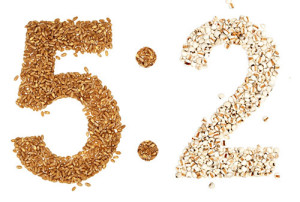Diets are like fashion: lots of them have a ‘Moment’ and become the hottest thing on everyone’s lips – in gym changing rooms, mind you, rather than in between the rails of Topshop. In this case, the ‘5:2 Diet’ is the dietary equivalent of this season’s adorable pale hues and textured outerwear, claiming the spotlight that has been previously claimed by Dr Atkins, Dr Dukan and Dr. ‘Low-GI’ (whoever that was). Pioneered in bestseller form by Kate Harrison (of ‘The 5:2 Diet Book’) and Mimi Spencer and Michael Mosely (of ‘The Fast Diet’), this current craze – made more palatable to the masses by suggesting a ‘two days on, five days off’ approach – refers to a practise called ‘Intermittent Fasting’ (IF). Different advocates of this weight-loss method recommend varying ratios of fasting to ‘normal’ eating, but ultimately IF is the practise of alternating between effectively starving oneself and eating normally, in a certain ‘windows’ of time.
 Fasting is, by no means, a new practise. Many religions fast ritually, as a means to hone self-discipline and sharpen faith. Mimi Spencer and Michael Mosely also make a clear point in ‘The Fast Diet’ that fasting is built into our evolutionary history; our ancestors would go for long periods of time without food. Throwing in descriptions of our ‘hunter-gatherer ancestors’ makes the whole thing sound rather exciting; we picture lean men and women charging after their prey in the wilderness without the merest ripple of fat on their athletic bodies. But let’s be honest – there is no history of men and women fasting so as to look better in a bikini. Except, of course, cases of tragic eating disorders – and this is a disease, certainly not something to be condoned and encouraged by doctors and dieticians.
Fasting is, by no means, a new practise. Many religions fast ritually, as a means to hone self-discipline and sharpen faith. Mimi Spencer and Michael Mosely also make a clear point in ‘The Fast Diet’ that fasting is built into our evolutionary history; our ancestors would go for long periods of time without food. Throwing in descriptions of our ‘hunter-gatherer ancestors’ makes the whole thing sound rather exciting; we picture lean men and women charging after their prey in the wilderness without the merest ripple of fat on their athletic bodies. But let’s be honest – there is no history of men and women fasting so as to look better in a bikini. Except, of course, cases of tragic eating disorders – and this is a disease, certainly not something to be condoned and encouraged by doctors and dieticians.
That said, there is a lot of evidence in favour of intermittent fasting (IF), who argue that fasting has become ‘taboo’ in diet culture for this very reason. They suggest that we should open our minds to the idea of using fasting as a tool to aid weight loss; furthermore, advocates of this weight-loss technique will tell you that IF can:
- Reduce blood glucose and insulin levels (improving the state of the overall glucose metabolism);
- Increase fatty acid oxidation with increased FFAs (through increasing lipolysis hormones GH, glucagon and adrenaline), while also sparing and preserving lean mass;
- Lower blood pressure;
- Keep the metabolism strong (arguing that eating more meals does not ‘speed up’ your metabolism).
When I first contemplated writing this article, I had only done basic research into the practise of fasting for weight loss, and by all accounts, the evidence seemed positive. It seemed that by going hungry for half a day, or even a whole day, at a time, yielded great results as far as losing weight is concerned (a bit of no-brainer, you’d think). But ultimately, one thing became abundantly clear about intermittent fasting: men and women respond very differently to it. For women, IF is not only less effective, but it also carries a lot of big risks.
In short: I’d be inclined to suggest that women are more likely to have negative experiences with intermittent fasting as a weight loss tool. And here, my dears, is why.
It affects your nervous system:
Daily fasts – with, for example, an eight hour ‘food window’ – run the risk of becoming chronic stressors and should be approached with caution by women; the same goes for longer (such as 24-hour) fasts interspersed between ‘normal’ eating days. We all fast at night when we sleep, and this is normal. However, when we fast during waking hours, we become more conscious of hunger – yes, I know, duh. But your hunger pangs are an indicator that your cortisol (‘stress hormone’) levels are on the up. The sympathetic nervous system engages at this point – the trouble is, most of us are already dealing with stressors that overstimulate the sympathetic nervous system. This causes cortisol levels to increase to a dangerous level. At a normal level, this would help the body deal with stressors by, for example, keeping us alert, calibrating heart beat and pressure, and so on. When cortisol levels become too high, however, our energy levels drop and we become more sensitive, both mentally and physically. The body will struggle to produce key hormones and the metabolism will drop. Boo.
Your fertility levels may drop:
To the human body, a low calorie intake signals famine; for women, the stress on the body means it can stop being fertile until food supplies return to levels that can support reproduction. In a study conducted using rats, the female rats responded to fasting very differently from the male rats:
… Female rats become better at finding and acquiring food when they fast, as if their bodies aren’t as well-equipped to deal with the stress of going without food. They also become less fertile, while the males actually become hornier and more fertile (probably to account for the females’ plummeting fertility). Ovary size drops (bad for fertility), adrenal gland size increases (which in rats indicates exposure to chronic stress), and menstrual cycles begin to dysregulate in proportion to the degree of caloric restriction. – (Read full study here).
Glucose tolerance will drop:
One study found that while IF improved insulin sensitivity in male subjects, female subjects saw no such improvement. In fact, the glucose tolerance of fasting women actually worsened – the article suggested that “alternate day fasting may adversely affect glucose tolerance in nonobese women but not in nonobese men”. An impaired glucose tolerance can lead to the development of diabetes and cardiovascular disease … not good.
–
So is intermittent fasting really a trend that has returned from our hunter-gatherer days for good? Well, I’m tempted to conclude with a ‘no’. At Supplement Judge we have made no secret of the fact that we are fans of a small, overall calorie deficit for weight loss rather than long durations of complete fasting. For women, the risks carried with IF are quite extreme – and ultimately, a lifestyle that revolves around intermittent fasting can be quite tiresome and isn’t one that most women would find easy to accommodate. If you think it might be right for you, try reducing the ratio to 16:8, so at least you are eating the right amount of calories on a daily basis and there are less uncomfortable, prolonged periods of hunger involved.
That said, we’d be very interested to hear from any ladies who have tried this method of weight loss with success – reach out in the comments, on Facebook or Twitter!
 Supplement Judge Unbiased Supplement Reviews – Do they really work??
Supplement Judge Unbiased Supplement Reviews – Do they really work??




